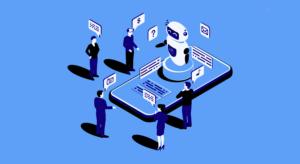We know that technological development is no longer only in the hands of the big web development brands, but is also part of medicine, retailing, sales, eCommerce, among others, so it is important to know what is needed to start working with GenAI (Generative Artificial Intelligence). Well, at Codster we are here to help you understand these types of new technologies so that your company is ready for this moment and can create dialogues, images, videos, code and more.
In fact, with data from CISCO, we know that most companies in Mexico and Latin America are little or not at all prepared to start working with GenAI and take this technological leap, so knowing this tool in depth will help you put yourself ahead of the competition.
In accordance with Jaime Teevan, principal scientist at Microsoft, has barely begun to explore what AI can do, so a first step to start working with GenAI is curiosity. One of the reasons this latest generation of AI tools has so much potential is its ability to allow people to interact with our computers. in the same way we communicate with other human beings over millennia: through natural language.
This represents a significant change.
Previously, the only way to communicate complex ideas to computers was through languages designed for them: writing precise formulas in spreadsheets, remembering keywords for email searches, or learning programming languages. Many of those limitations have disappeared; Now you can tell an AI what to do simply by expressing yourself in natural language.
While this ability to communicate with AI systems using prompts represents a significant advance, research shows that it also comes with an understandable learning curve.
Tools to start working with GenAI
The most advisable thing is to collaborate with a consulting firm that help you solve your doubts to start working with GenAI, as well as with the development of the generative artificial intelligence tools you need. Some of the skills needed are:
- Programming skills: Python is crucial in AI because of its libraries and community support.
- Machine Learning Fundamentals: Understanding concepts like supervised/unsupervised learning and neural networks is key.
- Choose the right framework: TensorFlow, PyTorch and Keras are popular. Evaluate ease, community support and compatibility with your project.
- Data sets and preprocessing: Quality data is vital. Collected from various sources and prepare them by removing noise and normalizing them.
- Training the generative model: Models like VAEs, GANs and RNNs are common. Train the model with processed data, adjust parameters and evaluate its performance.
- Ethical considerations: Generative AI has significant ethical implications, such as the spread of misinformation and deepfakes. Responsibility and ethics in its development are fundamental. Here, the Codster team will analyze how your company will have the best approach to these technologies.
- Real applications: In the end, the use of these tools must lead to the improvement of the company. Generative AI is used in health (medical images, drug discovery), art (paintings, music), content generation (chatbots, virtual storytelling) and finance (forecasting, investment strategies). It is versatile and valuable in all sectors.
On the side of the user like you, the path is a little easier. Fortunately, both development teams and people involved in innovation seek to make starting to work with GenAI more accessible to the general public. This can directly impact the results obtained.
In fact, a recent study with management consultants in BCG found that those who received training in prompt writing from experts on the subject were better able to harness the power of AI than those who did not.
Now, why is support with an expert team important? According to the University of Virginia, there are several important issues and benefits, especially regarding cybersecurity. For example, if you plan to have your students use these tools in an assignment, keep in mind that most GenAI tools require users to create an account using a cell phone number or other personal information.
Universities are considering offering these tools through an institutional license to address security, privacy, and equity concerns. Therefore, it is essential to provide alternatives to complete the task; Students should not be forced to create an account.
Students may have privacy or intellectual property concerns when uploading their original work to a Gen-AI tool, as this will add the work to the tool's dataset. If you design an assignment that involves students uploading their original work to a Gen-AI tool, it is essential to offer them alternatives to complete the assignment.

How to create a prompt?
Now, the most important thing to start working with GenAI after development is the message, the prompt. The Prompt is the user's request to artificial intelligence to create images, video, code or whatever you need.
What information does a computer need in an indication that a human might not require? How can you use that information to improve directions? Below are some theories and results from the scientific literature that can help answer these questions.
Provide more context
Psycholinguistics, which studies the psychological aspects of language, has taught us about the central importance of substantiation in any communication. Generally speaking, to get started with GenAI, grounding is the process of arriving at a mutually understood meaning through conversation, that is, making sure you are on the same page. For example, if people in a meeting share an understanding of the actions to take at the end of the meeting (and know that they share that understanding), it is probably because they have spent time informing what the next steps are.
The process of substantiating with a large language model is different from substantiating with someone else, as the model typically has less shared context. Making that context explicit in the prompt helps you get better results. For example, when I talk to a researcher on my team, we both know the brainstorming sessions we've had on the topic in the past, that person's skills, among other details, but large-scale language models don't. You know, at least for now.
Therefore, when starting to work with GenAI IA it can be useful to provide the most important aspects of the context that I know that the language model might not know. A person might consider it invasive to be told exactly what background information they need, but of course the language model wouldn't have that view.
Thanks to techniques like “retrieval augmented generation” and other recent technological advances, the amount of context you need to provide will significantly decrease. For example, AI can search your past emails and documents to get useful context. Your current context also provides grounding information. Some systems, for example, base the questions you ask about a meeting on the transcript of the meeting. That said, given how fundamental foundation is to effective cooperation, providing proper context to the language model will continue to be crucial.
Promote a dialogue with artificial intelligence
To start working with GenAI, it is important to divide complex requests into several steps. It can improve the interaction with Large Scale Language Models (LLMs) to obtain more satisfactory results. While there are more formal approaches, such as “thought chaining” prompts, informal strategies often work as well. Personally, I have found it more effective to first ask for a summary of the article I want to understand and then inquire separately about specific aspects. For example:
- Request a summary of the article, highlighting aspects of interest to a Microsoft executive with a research focus.
- What questions would this executive ask about the article? Include responses with quotes from the article whenever possible. If the answer is not explicit in the article, indicate: “The answer is not included in the article” or “The question is partially answered”, specifying the part of the answer and what additional information is required to complete it.
Knowing how to start working with GenAI is key to knowing which is the perfect tool for you. If you have even more questions, do not hesitate to request a consultation with Codster to learn more about the benefits and what Artificial Intelligence is for. Well, many of them depend on the specifications and needs that your own firm has. But, don't worry, we will surely find the perfect and ideal solution for you.






